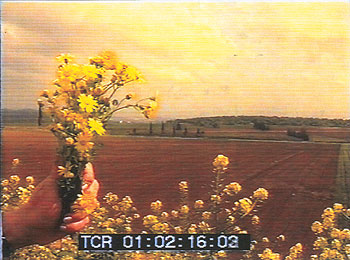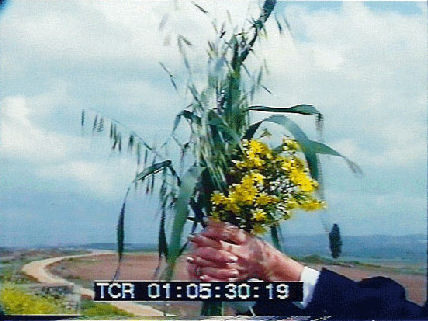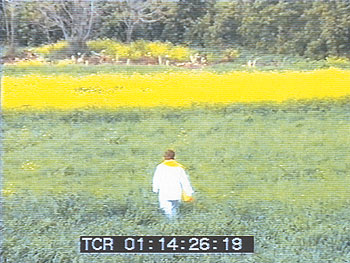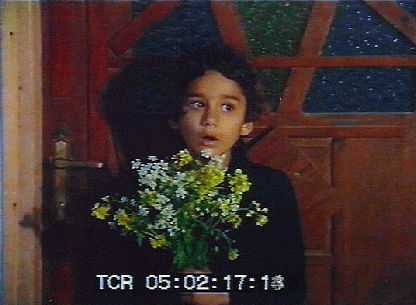

I noticed that the holes
under the modern forest
were not caves
but rooms

Out of peer pressure
more than heroism
he hesitatingly started
to eat
the yellow stuff

I shared a camel
called Ugly
with Palestinian Emily

This text was written in May 1999 for Rachel Sukman's Art magazine "Terminal", but it was never published. Rachel is an excellent art curator. She is the most important of those who made it possible for me to work in Israel, by inviting me for exhibitions, like "712 Borders", and asking me to write. She invited me to take part in her film "Yellow". This text is about the trips we made while shooting.
My first sabra was cut and peeled by a bedouin woman, sitting next to the supermarket. As I had read many times that the inside was sweet and tasty, I had high expectations, but what I put in my mouth was very disappointing. There might have been a slight reminiscence of sweetness, but it had no taste at all and the substance reminded me of the vegetables my mother used to serve, after suffocating them slowly in boiling water. It might have been that I ate that sabra at the wrong moment: water, my most beloved drink, also does not taste sometimes, for instance after eating an apple. But every sabra I tried gave me the same bad experience. A myth seemed to be broken, although I still imagine that, after wandering through the desert for many days, being dehydrated by the burning sun, finding a sabra cactus and eating one of its fruits must be like entering paradise.
Ruins
The first time I saw sabra cactuses, was when I was wandering through the forested hills west of Jerusalem. I was told they were once used as fences, a much nicer and respectable way of demarcating land than the huge amounts of barbed wire, which I can see from my Jerusalem window. I found more and more of them and always, where I found sabras, I also discovered all kinds of fruit trees, and lots of olive trees. Sometimes, I ended up at a neglected pool of water. One time, I noticed that the holes under the modern forest were not caves, but rooms: I was standing on what had once been a roof. Sometimes the trees seemed to form a village square and as I found more and more leftovers of houses I got convinced that the area once had been very populated. Naive as I was, finding no information at all about the history of the region, except about the Burma Road, I kept thinking that the ruins were Byzantine or Roman.
Wiped out
Recently Hadassa, Alma and I landed in Park Canada, a piece of West Bank territory close to Latrun. It was full of people, sitting in the beautiful landscape, eating drinking and talking. We drove a little further, where it was empty, parked the car and walked downhill. We found a long water system, a canal made of stones, with tunnels and stairs, bordered by fruit trees. The ground was covered with flattened figs. There were signs, indicating that there had been the Roman town of Emmaus. It was wonderful to see how the fruit trees had survived so many years. We followed the canal until the end, where many people, Jews and Arabs alike, were picnicking peacefully in the lawn around a large pool. Only at home, studying an Israeli map from before 1967, I found out that there had been the Arab village of Amwaz. A guide to the Holy land, published by the Franciscans in Jerusalem, mentioned that it was completely wiped out in 1967.
Strauss ice cone
Although I had to cancel my first trip with an Arab to the location of his former village, near Abu Gosh, I accepted Rachel's invitation to be filmed with other artists while eating, drinking and seeing landscapes. We, as artists, were supposed to say sensitive things about food, drink and landscape. My thoughts about sabras came to my mind, but anything political she would cut from the film. Everything about politics has already been said, according to Rachel. I think, however, it is almost impossible to make any step or to say anything in this country which is not political. There is a huge difference between eating oranges in Tel Aviv or eating oranges in Jericho; drinking wine from the Golan has a very different meaning than drinking wine from Cremisan near Bethlehem. The four shekkel Strauss ice cone, which I usually eat, tastes much different than the almost identical Strauss ice cone, stripped from its topping of nuts and chocolate, which I found for half the price in East Jerusalem and in the Palestinian village of Qubeibeh.
Political
So in the early morning of Wednesday the 14th of April 1999 I found myself driving to the landscapes of the north with Rachel, a cameraman and a soundman in a car loaded with equipment. In a road restaurant near Alonim, founded in the meaningful year of 1948, I shook hands with the other artists: Asad the Druze, Farid the Arab, Emily the Palestinian American and Shuli, Ronen and Yuval the Israeli Jews. We had a small breakfast. Soon I heard the first discussion which seemed political, but as it was in Hebrew I missed the context. Emily did not understand Hebrew at all, it was actually her first stay in Israel, and maybe therefore we found a lot of understanding in English. Ilan, our driver advised me to take a sandwich for the way, as we would get a meal only late in the afternoon.
Leftovers
Our first location was in the Golan, close to the Banyas nature reserve, where we visited the grave of a Druze sheik. There came some people praying, like I had seen at a grave site up the hills of Amwaz. The middle room of the adjacent crusader castle gave way to the leftovers of a broken concrete water bridge over the river, deep below. Somebody said Syrian officers once had a good time there. A hundred meters further I saw a relatively modern church with a big hole in its front wall. Around that church I found leftovers of houses. We artists spend some time at a huge table, which was set up next to the grave site, sitting and talking, I do not know about what. I never was a big talker, also not in Dutch. I always compensated for not talking by writing, as all my teachers, from high school to university, stated, up to the solemn moment I received my degree in art history. After two days of filming Rachel said that, after seeing all the material, she hardly noticed me talking.
Sour fruit
We were directed like school kids to the Banyas nature reserve, where we had to parade up and down before the camera. We were rewarded with an ice cream and drove to Klil, not far from Nahariya, passing through the impressive mountain landscape just south of the border with Lebanon. I would not know how to describe the views in words. While Rachel and her crew were filming a hill which was covered with yellow flowers Shuli gave me some unripe fruits, saying she used to eat them in her youth. During the rest of the ride I obediently tried to eat the bitingly sour fruit. On the way I saw the sign to park Bar'am, the former Christian Arab village Bir'am, which I had visited recently and where I had seen the restored ruins of the antique synagogue and the destroyed village church.
Garlic
In Klil we were served cheese and wine by Jano, with whom I had shared a studio in a Jerusalem bomb shelter. I did not see him very much there, because he was building his tomb-like house in the north, on land he had bought from a Druze from a nearby village. The excellent cheeses were made by a local in Klil; the wine was made by Jano himself. Soon I felt the alcohol taking possession of my brain. The others were talking while being filmed, but I dreamed away to my youth, when food was not something that could be enjoyed. At five in the afternoon, my mother usually started to peel potatoes. A little later our house in The Hague was filled with the noxious vapours of vegetables, being killed in boiling water, and the heavy smell of meat, being suffocated in cheap margarine. At times the potatoes burned. I used to be hungry at that time of the day, but what came to my nose made me usually very depressed. On the stroke of six we were forced to eat. My sisters sometimes went to the toilet to get rid of what was in their mouth, but I was obedient and ate the stuff, although I almost had to vomit, especially when the slimy vegetables went through my throat. Salt saved my life, but about spices I only heard at geography, when I was taught about our former colony Indonesia. That they could be used in food, however, I did not grasp. So deprived I was of them, that when I first smelled garlic, in the house of a fellow boy scout, whose parents came from Indonesia, I thought the strange smell came from those exotic people themselves. Their excellent dishes I only learnt to eat many years later.
Smell of goats
Our way of eating started to change after my father, a high civil servant dealing with radio frequencies, had taken part in a conference around 1965 in Geneva. There he went to a restaurant every day and he looked horrified at the strongly smelling cheeses that he got for dessert. As a Dutchman, he only knew Dutch cheese, with its excellent but rather plain taste, young and fresh or old and sharp. Out of peer pressure, more than heroism, he hesitatingly started to eat the yellow stuff with its odour of a stable. As the conference lasted two months, he learned to like Swiss and French cheeses and he took a lot of them back home. Again and again he told how the Dutch passengers in the KLM airplane looked around, wondering where that heavy smell of goats came from. He also took wine and so we started a custom of eating foreign cheeses and drinking wine on Saturdays, which lasted until his death in 1994.
Intonation
Although the Klil cheeses did not have that sublime quality of what we had imported from France, Switzerland and Italy, they tasted much better than the disgusting gummy-like mass that we sometimes buy in the Jerusalem supermarket. I ate and ate and as far as I remember I did not state any of the thoughts I mentioned here. I repeat, I am a bad speaker. And when I finally start to say something I do it without any intonation and so slow that others think I am finished after my first sentence and start to talk about something else.
Coffee
From Klil we were taken to Daliat-Al-Karmel, where Druze writer Salman Nattour was going to prepare coffee for us. After leaving the cars and walking to the location with a magnificent view over the plains to the east, Salman, Farid, Asad and Emily were walking next to each other, as in a sub-group, slightly ahead of the others. Rachel whispered in my ear "Look, the Arabs stick together, like always!" Salman prepared coffee and not one moment again did I notice that the Arab speakers were sticking together.
A camel called Ben Gurion
The second day seemed more political than the first one. There was an extra crew, there was an extra driver and there were four more artists: Noam, Miriam, Simcha and Sigal. Farid did not come and thus the Jewish presence was much stronger. We were taken to a Jewish settlement in the West Bank, Alon. American Palestinian Emily noticed immediately the row of new houses under construction. We were put on camels with Hebrew names on their saddles, led by two or three young settlers. I shared a camel called Ugly with Emily, and because it was quite inobedient we later took another one, called Ben Gurion. His back was much softer. Emily said the only time she sat on a camel was in Paris. My first camel I rode not long before in the Jordan valley, invited by Ibrahim, a young bedouin. He lives with his wife and little daughter Adir in a tent next to a road restaurant. He sells the same kind of oriental souvenirs as can be found in the Jerusalem Old City bazar and to add to the oriental atmosphere he keeps a camel. He served us strong and sweet tea and made me ride the animal.
Salads
At a location with a wonderful view of Wadi Qelt we were served tea and coffee, salads and pita bread. I love those salads. I ate them in the restaurants in Abu Gosh and at the market of Jerusalem. I ate them at weddings, at circumcision parties and I ate them just because I was hungry and every time they were followed by a rather disappointing piece of meat and potatoes, reminding me a little bit of my mother's food. So I learned to concentrate on those various lovely salads and leave the main dish to others.
Soft like a peach
After riding back on the camels, we were transported to a spot at the Dead Sea, where we were supposed to take a mud bath. The sensation of not sinking is nice for a few minutes, but I like to swim and I would be very happy if the Dead Sea would be connected with a pipe to the Red One, so it can be filled with normal seawater. After swimming I covered myself with mud and sat for a while, being totally black, until the layer on my face started to crack. After I had cleaned myself in the salty water and under the sweet shower my skin was soft like a peach.
Colorful orientals
All those soft skins were taken in the afternoon to Jericho for the big meal of the day. After we had crossed the border to Palestinian Area A, at around three Israeli time (The Palestinians had not yet moved to summertime), Emily said that she immediately felt at home. I did not write down her exact words, but she seemed to feel much more happy and glad in what she considered her home country. It might have had to do with a holiday feeling, she admitted, as she never lived in Palestine, only spent summers in her grandmother's house in Bethlehem, or with her family in Gaza and Jordan. She was born in the States, grew up in Saudi Arabia, lived some time in Italy and, if I remember well, also in France, and now again in the States. She noticed that the restaurant where we were taken was called "oriental". I just had told her the theory that the Jews, or the Israelis, especially the Ashkenazis, see the Arabs as colorful orientals, to whom they can go as tourists, from whom they buy oriental souvenirs and with whom they eat oriental food. With a similar viewpoint I wandered between 1973 and 1988 through what then was Yugoslavia and enjoyed oriental hospitality in Slovenia, in Croatia, in Macedonia, in Serbia, in Kosovo and especially in Bosnia. There I learnt that hospitality and food belong to each other, unlike what I grew up with in Holland. Only a few of the many dishes offered I remember: a plate of chevapchichi, given me for free by a Croatian waiter after asking him for food in my best Serbocroatian, and the bread made from corn I ate in a Bosnian village not far from Bihac, after I had fallen in love with a local beauty and was rejected by her father because I wasn't a Moslem. I wonder who of her family is still alive and whether the village still exists.
Fingers
The oriental restaurant in Jericho served variations of my favorite salads. We drunk Palestinian mineral water and Palestinian beer. After the salads we ate kebab with white rice, which, to add to orientality, we had to eat with our fingers. The meal in that restaurant differed much from the picnic we made two months earlier with Arab friends close to Hisham palace, where once had been a blooming restaurant, but now only the concrete floor and the toilets remained. We heard Palestinian schoolchildren loudly singing songs about Palestine.
Jacer Palace
I spent a third day with Rachel, her husband Suki, Ronen and Emily. While waiting for them at the New Gate I ate such a two shekkel Arab Strauss ice cone. The first attraction, after visiting the new Al Mamal cultural centre in the old city of Jerusalem, was the palace that Emily's forefathers had built in Bethlehem around 1900, and owned until they lost their fortune in the thirties. We put the car in a heavily guarded parking lot opposite Rachel's Tomb and entered the huge Jacer palace. Walls and ceilings of the many rooms were still covered with European style figurative paintings. It had a huge courtyard and, being changed into an Intercontinental hotel, it might compete with the American Colony hotel in East Jerusalem. The workers served us coffee. The villa next to the palace, where Emily's grandmother had lived until recently, seemed small.
Military reserve duty
The next attraction in Bethlehem was the Church of the Nativity, where we were driven in the Mercedes of Rami, a friend of Emily. We also saw the Franciscan church attached to it, where she was baptised. The main attraction for me was, however, driving in the Palestinian numbered Mercedes through Har Gilo, which Rami from Bet Jala called almost soothingly "our own settlement". The settlers there, he added, were of a less bad kind. The guard let our car in after he heard that there were native Hebrew speakers aboard. He said he just was doing his military reserve duty. While making one round I asked jokingly, but with a very slight serious fear, if they would not shoot at us there. Rachel said "Henk, I hate your attitude!" In the nearby restaurant called "Everest" we ate salads and kebab. After that meal we went back to our Israeli numbered car, said goodbye to Emily and Rami and drove back over the border to Israel.
Bananas
One more day I took part in filming. Rachel took me from Jerusalem to Jaffa to be filmed while eating fruits. So I did, together with some of the other artists from the days before. I ate an apple, a banana and a fig. I tried two sabras, but also now I did not like them. At the end of the session I was interviewed alone. That should have been done Thursday in Jericho, but I had been forgotten. I stated that I am addicted to bananas and I told the camera a fragment of what I wrote here about sabras. As usual I forgot most details, being a bad speaker.
Henk Puts, Jerusalem, May 1999


